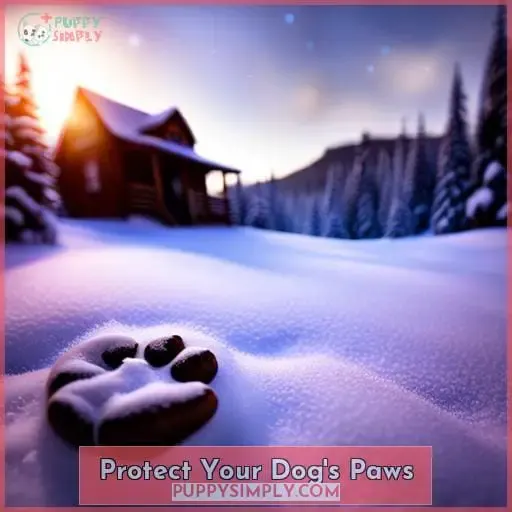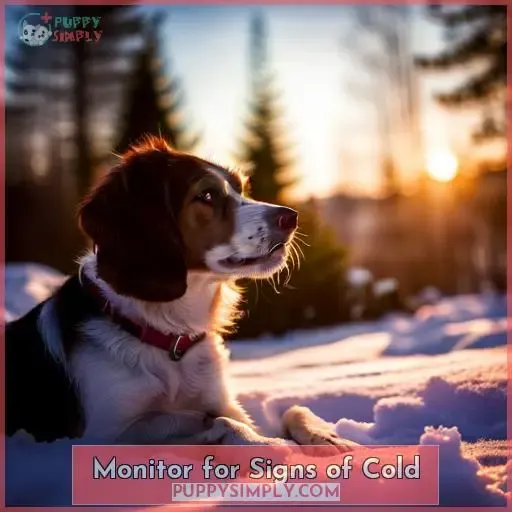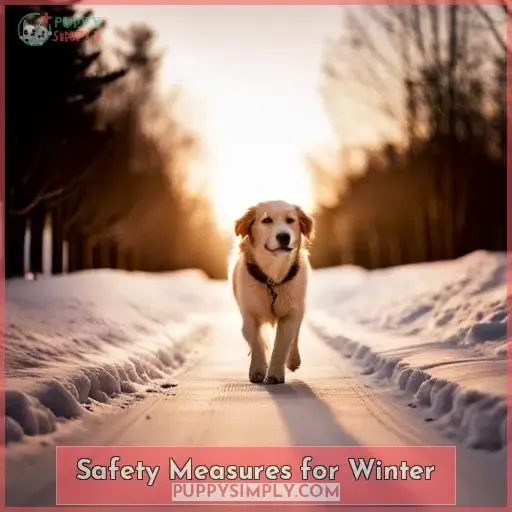This site is supported by our readers. We may earn a commission, at no cost to you, if you purchase through links.
 Imagine stepping outside on a frosty winter morning, feeling the chill in the air and wrapping yourself up in warm layers. Now imagine your furry friend, your loyal companion, right by your side. Just like you need to prepare for the cold weather, so does your dog.
Imagine stepping outside on a frosty winter morning, feeling the chill in the air and wrapping yourself up in warm layers. Now imagine your furry friend, your loyal companion, right by your side. Just like you need to prepare for the cold weather, so does your dog.
In this article, we’ll provide you with essential tips to keep your dog warm and safe during those chilly winter months.
Table Of Contents
- Key Takeaways
- Limit Outdoor Time
- Bundle Up Your Dog
- Protect Your Dog’s Paws
- Provide a Warm Sleeping Area
- Monitor for Signs of Cold
- Groom and Moisturize
- Avoid Winter Hazards
- Adjust Diet and Water Intake
- Provide Mental and Physical Stimulation Indoors
- Safety Measures for Winter
- Frequently Asked Questions (FAQs)
- Can I use regular moisturizer on my dog’s paws during winter?
- How often should I trim my dog’s foot fuzz to prevent ice ball formation?
- Are there any specific hazards I should be aware of when walking my dog during winter?
- What are some signs that my dog may be experiencing hypothermia?
- How can I ensure my dog stays mentally stimulated during the winter months?
- Conclusion
Key Takeaways
- Limit outdoor time during winter and use protective attire to keep dogs safe from the cold weather.
- Provide indoor enrichment activities and comfortable bedding for mental stimulation and comfort during the winter months.
- Use booties or paw protectors, and clean and moisturize paws regularly to prevent frostbite and maintain paw health.
- Create cozy sleeping areas away from drafts, with added insulation and bedding for warmth and comfort.
Limit Outdoor Time
To keep your dog warm and safe during winter, it’s important to limit their outdoor time.
When possible, stay indoors where it’s warmer and more comfortable for your furry friend.
If you do need to take them outside, opt for short walks during the daytime when temperatures are milder.
Stay Indoors When Possible
Limit your dog’s outdoor time in the winter to keep them safe and warm.
Instead, focus on providing indoor enrichment and entertainment for your furry friend.
Engage in winter games, set up cozy retreats with heated dog beds or blankets, and try out new indoor activities to keep them mentally stimulated.
Make sure their bedding is comfortable and create a cozy environment where they can enjoy various indoor dog activities during the cold months.
Take Short Walks During the Daytime
Spend less time outdoors and opt for brief daytime walks to ensure your dog’s safety and warmth during the winter months.
Taking short walks during the day allows your furry friend to get some exercise while enjoying the winter sun. It’s important to prioritize canine exercise, but remember to keep these outings limited in duration.
This will help prevent your dog from getting too cold or experiencing any potential weather-related issues.
Make sure you have a sturdy leash for added safety during daytime dog walks.
Bundle Up Your Dog
To keep your furry friend warm and cozy during the winter months, it’s important to bundle them up with appropriate winter attire.
Consider their age and breed when selecting the right clothing options.
Dogs with thin coats may benefit from wearing sweaters or jackets in freezing temperatures, while breeds with thick coats may require less protection.
Make sure the attire fits well without restricting movement, providing both warmth and comfort for your dog during chilly outings.
Use Appropriate Winter Attire
When it comes to keeping your dog warm during the winter months, it’s important to use appropriate winter attire that will help bundle them up and provide extra insulation against the cold.
Give your pup some style with canine fashion by choosing doggy jackets that are both functional and fashionable.
Protect their paws from frostbite with booties or paw protectors, ensuring they stay safe while looking fabulous in their winter wear.
Consider Your Dog’s Age and Breed
To keep your dog warm and safe during the winter months, make sure to consider their age and breed when bundling them up.
Age considerations are important as puppies and older dogs struggle more with temperature regulation.
Breeds with thin coats may require additional layers such as coats or sweaters to help retain heat.
Indoor playtime can also provide exercise for your dog while keeping them warm.
Additionally, pay attention to specific care needs such as winter grooming and paw care to ensure overall well-being in colder weather conditions, particularly for senior dogs prone to hypothermia awareness.
Protect Your Dog’s Paws
To protect your dog’s paws during winter, consider using booties or paw protectors.
These can provide a barrier between your dog’s feet and the cold ground, preventing frostbite and other injuries.
After walks, make sure to clean your dog’s feet thoroughly to remove any ice balls or deicing substances that could irritate their paws.
Use Booties or Paw Protectors
To protect your dog’s paws from the cold and potential hazards, consider using booties or paw protectors.
These protective gear provide a barrier between your dog’s delicate pads and the harsh winter elements. They’re especially useful during outdoor adventures and winter playtime to keep their feet safe and comfortable.
Paw protection is essential for maintaining foot health in colder weather, preventing frostbite, injuries, and irritation caused by ice, snow, salted roads or sidewalks.
Clean Your Dog’s Feet After Walks
After your dog’s winter walks, remember to clean their feet thoroughly to protect their paws.
- Use warm water and a gentle pet-safe cleanser.
- Pay attention to the areas between the toes and pads.
- Dry their feet completely using a towel or hairdryer on low heat.
- Consider applying a paw balm or moisturizer for added protection against dryness and cracking.
- Regular foot trimming can help prevent ice ball formation.
Provide a Warm Sleeping Area
To ensure your dog stays warm and comfortable during the winter, invest in a heated dog bed.
These beds provide an extra layer of warmth and can be especially beneficial for senior dogs or those with arthritis.
Additionally, create a cozy sleeping spot away from drafts by placing the bed in a quiet corner or against a wall.
Providing your dog with a warm and snug place to sleep will help them stay safe and protected from the cold temperatures.
Invest in a Heated Dog Bed
For a cozy and warm sleeping area, invest in a heated dog bed to ensure your furry friend stays comfortable throughout the winter. A heated dog bed provides numerous benefits, including temperature regulation and creating a cozy indoor retreat for your pet.
It’s especially beneficial for senior dogs who may struggle with cold temperatures. Investing in a heated dog bed is one of the best winter sleeping solutions to keep your dog safe and snug during chilly nights.
| Heated Bed Benefits | Temperature Regulation | Cozy Indoor Retreat |
|---|---|---|
| Provides warmth | Helps regulate body | Creates a comfortable |
| throughout the night. | temperature during cold indoor space where | |
| winter nights dogs can rest undisturbed. |
Create a Cozy Spot Away From Drafts
Ensure your dog has a cozy spot to sleep by creating an area away from drafts.
Find free nooks in your home where you can set up a sheltered sleep area for your furry friend.
Consider using cozy corner tips like placing their bed against a wall or adding blankets for extra warmth.
Indoor warmth solutions, such as heated beds or warm bedding ideas, will help keep them comfortable during the winter months while protecting them from potential health risks like hypothermia.
Don’t forget to prioritize grooming and regular cleaning of their sleeping area for optimal winter protection and overall well-being.
Create a Cozy Spot Away From Drafts (Provide a Warm Sleeping Area)
To ensure that your beloved canine companion gets quality rest during the chilly winter nights, it’s important to create a cozy spot away from drafts in which they can sleep peacefully. Free nooks around your home are perfect places to set up sheltered sleep areas that provide both comfort and safety.
Consider utilizing some helpful cozy corner tips when setting up this dedicated sleeping space for your furry friend:
- Position Their Bed Against A Wall: By placing their bed against an interior wall of the house instead of near windows or doors, you can minimize exposure to cold air currents coming through cracks or gaps.
- Add Extra Layers Of Warmth: Enhance the coziness factor by adding soft blankets on top of their beddings – these layers act as insulating materials that trap heat effectively.
In addition to these simple adjustments, there are various indoor warmth solutions available on the market specifically designed with dogs’ comfort in mind:
- Heated Dog Beds: These innovative products offer adjustable temperature settings so you can cater precisely to your dog’s needs. They provide consistent and gentle warmth that keeps your pet comfortable throughout the night.
- Winter Bedding Ideas: Look into specially-made pet beds designed for colder seasons; some feature thicker padding materials while others have built-in heating elements for extra warmth.
Creating a warm sleeping area not only helps your dog stay comfortable, but it also plays a crucial role in their overall winter protection. It minimizes the risk of hypothermia and ensures that they’re well-rested and ready to face the day ahead.
Remember to regularly groom your dog during winter as well. Regular brushing helps maintain their coat’s insulation properties by removing dead hair, allowing them to better regulate body temperature. Additionally, consider investing in quality grooming tools like pet-safe moisturizing shampoos or conditioners specifically formulated for dry skin.
By following these simple steps and providing a cozy spot away from drafts, you can ensure that your furry friend stays warm throughout the winter season while enjoying restful sleep.
Monitor for Signs of Cold
When caring for your dog during the winter months, it’s important to monitor them closely for signs of cold.
Frostbite and hypothermia are serious conditions that can affect dogs in colder temperatures.
- Pale or grey skin
- Shivering
- Lethargy
- Reluctance to move
By recognizing these signs early on and taking appropriate action, you can ensure your dog stays warm and safe throughout the winter season.
Recognize Symptoms of Frostbite and Hypothermia
To keep your dog warm and safe during winter, it’s important to be vigilant and monitor for signs of cold stress, including symptoms of frostbite and hypothermia.
Recognizing the signs of these conditions is crucial for prompt intervention.
Look out for pale or grey skin, especially on the ears, paws, tail, or nose as this may indicate frostbite.
Signs of hypothermia include shivering uncontrollably and lethargy.
If you notice any of these symptoms in your dog after being exposed to low outdoor temperatures, seek veterinary attention immediately to prevent further complications.
Observe Your Dog’s Behavior for Signs of Discomfort
Pay attention to how your dog is behaving, especially if they’re showing signs of discomfort in the cold weather.
- Excessive shivering or trembling
- Whining or seeking warmth indoors
- Reluctance to walk or play outside for extended periods.
By monitoring these behaviors, you can recognize early signs of cold and take appropriate measures to keep your furry friend safe and cozy throughout the winter season.
Groom and Moisturize
To keep your dog’s skin and coat healthy during winter, grooming and moisturizing are essential.
Consider using skin and coat supplements to prevent dryness and flakiness.
Additionally, applying natural moisturizers like coconut oil can help maintain the moisture balance of your dog’s skin.
Use Skin and Coat Supplements
Take care of your dog’s skin and coat during the winter months by using skin and coat supplements.
These supplements provide numerous benefits, including:
- Promoting a healthy coat
- Preventing dryness and flakiness
- Supporting overall skin health
Along with proper grooming tips such as regular brushing to distribute natural oils, incorporating these supplements into your dog’s winter diet can help maintain their coat health despite the harsh weather conditions.
Remember to also engage in indoor exercise activities to keep your furry friend active during colder days.
Apply Natural Moisturizers Like Coconut Oil
For grooming and moisturizing your dog during the winter, apply natural moisturizers like coconut oil to keep their skin and coat healthy.
- Make a DIY Paw Balm using ingredients like beeswax, shea butter, and coconut oil for extra paw protection.
- Consider adjusting your dog’s diet for the winter months to promote a healthy coat from within.
- Engage in indoor exercises like puzzle toys or obstacle courses to keep them mentally stimulated during colder days.
- Look for pet-friendly moisturizers that contain natural ingredients such as oatmeal or aloe vera.
By following these tips, you can ensure that your pup stays comfortable and protected throughout the cold weather playtime season!
Avoid Winter Hazards
When it comes to winter hazards, there are a few key things to keep in mind for the safety of your dog.
Firstly, be sure to keep your dog away from toxic substances like antifreeze which can be extremely harmful if ingested.
Additionally, exercise caution with space heaters and other potential hazards that could pose a danger to your furry friend.
By being aware and taking necessary precautions, you can ensure a safe and enjoyable winter season for both you and your dog.
Keep Your Dog Away From Toxic Substances Like Antifreeze
To keep your dog safe during the winter months, be mindful of avoiding toxic substances like antifreeze.
Antifreeze contains ethylene glycol, which is highly poisonous to dogs. Even a small amount can be fatal if ingested.
Keep antifreeze securely stored in sealed containers and clean up any spills immediately.
Symptoms of antifreeze poisoning include vomiting, diarrhea, excessive thirst or urination, seizures, and even coma or death.
Seek veterinary help immediately if you suspect your dog has ingested antifreeze.
| Winter Toxins | Canine Safety |
|---|---|
| Antifreeze | Store Securely |
| Ethylene Glycol | Clean Up Spills |
| Risks | Seek Veterinary Help |
Ingesting even a small amount of antifreeze containing ethylene glycol can have severe consequences for your furry friend’s health and well-being during the winter season.
Symptoms may include:
- Vomiting
- Diarrhea
- Excessive thirst or urination
- Seizures
- Coma
- Death
It is crucial to store all forms of this substance safely out of reach from curious noses by sealing them tightly after use.
Cleaning up any accidental spills quickly will also prevent potential harm.
[SOURCE CREDIT]:
Pet Poison Helpline
Be Cautious of Space Heaters and Other Potential Hazards
To ensure your dog’s safety during winter, be cautious of potential hazards such as space heaters and other dangerous objects.
Space heaters can pose a burn risk to curious pets, so it’s important to keep them out of reach or use pet-friendly heating alternatives instead.
Be mindful of cords that could be chewed on and cause electrocution.
Consider using radiator covers or other safe indoor heating methods to protect your furry friend from harm.
Adjust Diet and Water Intake
To ensure your dog stays healthy and hydrated during the winter months, it’s important to adjust their diet and monitor their water intake.
Adding skin and coat supplements to their food can help prevent dry, flaky skin caused by cold weather.
Additionally, be sure to provide fresh water at all times, as dogs may be less inclined to drink in colder temperatures.
Add Skin and Coat Supplements to Their Diet
To ensure your dog’s skin and coat stay healthy during the winter months, regularly add skin and coat supplements to their diet.
These dietary enhancements provide essential nutrients that support coat health and overall wellness. Supplements can help prevent dryness, flakiness, and itchiness by providing nutritional support from within.
By adjusting your dog’s diet and water intake accordingly, you can give them a much-needed wellness boost during the colder months.
Monitor Water Intake and Provide Fresh Water
Monitor your dog’s water intake and make sure they’ve access to fresh water throughout the winter.
Here are some tips to keep in mind:
- Check their water bowl regularly and refill with clean, fresh water.
- Be aware of potential freezing of outdoor bowls; consider using heated bowls or bringing them inside.
- Adjust their diet accordingly to ensure proper hydration levels.
- Keep an eye out for signs of dehydration, such as dry gums or excessive panting.
By staying vigilant about your dog’s water intake, you can help prevent dehydration and promote overall well-being during the winter months.
Provide Mental and Physical Stimulation Indoors
Keeping your dog mentally and physically stimulated during the winter is crucial for their well-being.
Engaging in new indoor games and activities can provide mental exercise, keeping them entertained and preventing boredom.
Additionally, exploring interactive dog toys can help stimulate their senses and keep them engaged even when they’re confined indoors.
Engage in New Indoor Games and Activities
Keep your dog entertained and mentally stimulated during the winter months by engaging in new indoor games and activities.
Winter playtime is essential for maintaining your dog’s physical health and mental well-being.
Explore interactive toys that challenge their problem-solving skills or set up indoor obstacle courses to keep them active.
Cold weather games like hide-and-seek or puzzle feeders provide enrichment while keeping them warm indoors.
Get creative with different activities to ensure your furry friend stays engaged throughout the winter season.
Explore Interactive Dog Toys for Mental Exercise
Enhance your dog’s indoor experience during the winter months by providing mental and physical stimulation through interactive dog toys.
Interactive playtime is essential for canine enrichment, keeping their minds sharp and bodies active.
Puzzle toys challenge your dog’s problem-solving skills, while DIY dog games engage their senses.
Consider setting up an indoor agility course using household items to promote exercise and coordination.
These activities will keep your furry friend entertained, happy, and mentally stimulated during the colder months.
Safety Measures for Winter
When it comes to winter safety for your dog, there are a few important measures to keep in mind.
First, be aware of potential dangers like thin ice when walking near bodies of water.
It’s crucial to never leave your dog unattended in a car during any season and especially during the cold winter months.
Taking these precautions will help ensure the safety and well-being of your furry friend throughout the winter season.
Be Aware of Potential Dangers Like Thin Ice
To ensure your dog’s safety during winter walks, it’s important to be aware of potential dangers like thin ice.
Frozen ponds and bodies of water may pose risks as dogs can accidentally fall through the ice.
Always keep your dog on a leash and avoid walking near frozen water unless you’re certain it’s safe.
It’s crucial to stay vigilant and prioritize the safety of both you and your furry friend when navigating cold weather hazards.
Never Leave Your Dog Unattended in a Car During Any Season
Are you aware of the potential dangers of leaving your dog unattended in a car during any season?
Car safety is crucial, especially during winter. Vehicles can quickly become dangerously cold or unbearably hot, putting your pet’s life at risk. Extreme temperatures inside a parked car can lead to frostbite or heatstroke within minutes.
It’s essential to take seasonal precautions and never leave your dog alone in a vehicle, ensuring their safety and well-being at all times.
Frequently Asked Questions (FAQs)
Can I use regular moisturizer on my dog’s paws during winter?
Yes, you can use regular moisturizer on your dog’s paws during winter.
Look for pet-safe options without harmful ingredients.
It helps keep their paws moisturized and protected from dryness and cracking caused by cold weather conditions.
How often should I trim my dog’s foot fuzz to prevent ice ball formation?
To prevent ice ball formation, regularly trim your dog’s foot fuzz during winter.
Aim for once every two weeks, but adjust based on your dog’s coat length and outdoor activity level.
Are there any specific hazards I should be aware of when walking my dog during winter?
When walking your dog during winter, be cautious of potential hazards.
- Watch out for icy patches and slippery surfaces to prevent falls.
- Also, avoid areas where deicing substances may damage your dog’s paw pads.
What are some signs that my dog may be experiencing hypothermia?
When your dog starts shivering uncontrollably, becomes lethargic, and seems reluctant to move, it could be a sign of hypothermia.
Keep an eye out for these symptoms and act quickly to warm them up.
How can I ensure my dog stays mentally stimulated during the winter months?
To ensure your dog stays mentally stimulated during the winter months, engage in new indoor games for mental exercise.
Explore interactive toys to keep them entertained.
Consider puzzle feeders or treat-dispensing toys to challenge their problem-solving skills.
Conclusion
To ensure your furry friend stays warm and safe during the winter months, follow these essential tips for dog care:
- Limit outdoor time.
- Bundle up your dog with appropriate winter attire.
- Protect their paws with booties or paw protectors.
- Provide a warm sleeping area away from drafts and monitor for signs of cold.
- Groom and moisturize their skin and coat.
- Avoid winter hazards.
- Adjust their diet and water intake.
- Keep them mentally and physically stimulated indoors.
- Always prioritize their safety.
Take care of your dog in winter and keep them cozy and happy.
















